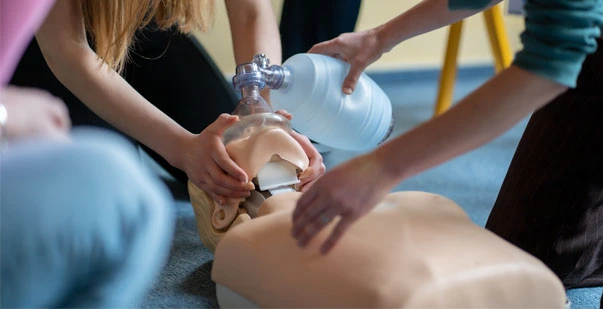Every year, crisis call for quick actions that can save lives. Rescue breathing and cardiopulmonary resuscitation (CPR) are two of the most well-known. These two approaches have different methods and goals, despite the fact that they are frequently confused in public perception. In addition to improving one’s capacity to react appropriately in an emergency, being aware of their distinctions helps dispel some myths. Both methods are fundamental components of first aid instruction, giving rescuers the tools they need to handle life-threatening situations. People can develop the self-assurance necessary to take decisive action when every second matters by investigating their particular roles and applications.
What Are CPR and Rescue Breathing?
At the heart of emergency care, CPR and rescue bathing serve pivotal roles when someone’s life hangs in the balance. CPR is a combination of chest compressions and rescue breaths, executed to maintain blood and oxygenation when the heart has stopped. Conversely, rescue breathing focuses solely on providing breaths to someone who cannot breathe independently but still has a pulse.
CPR: A Comprehensive Technique
CPR combines mechanical support through chest compressions with artificial respiration, aiming to restore partial flow of oxygenated blood to vital organs such as the heart and brain. It is applicable when a person is unresponsive and not breathing, impeding brain damage and increasing survival odds until professional help arrives.
Rescue Breathing: Focus on Oxygenation
Unlike CPR, rescue breathing is used when the heart continues to beat, but the person is not breathing effectively on their own. It’s a focused technique to provide oxygen, assisting until spontaneous breathing resumes or advanced help is available.
The Mechanics: How Each Technique Is Performed
Grasping the procedural differences between CPR and rescue breathing is vital for effective execution. Both require distinct actions and attention to symptom indications.
CPR: More Than Just Breathing
CPR primarily focuses on:
- Chest Compressions: Established as the core of CPR, chest compressions involve pressing down hard and fast in the center of the chest, typically at a rate of 100 to 120 compressions per minute. This action is crucial to mimic heartbeats and maintain blood circulation.
- Rescue Breaths: Following every 30 compressions, two rescue breaths are given when one is trained in CPR. The head is tilted back, and the nose is pinched closed to deliver breaths directly into the person’s mouth, inflating the lungs.
Rescue Breathing: A Precise Aid
When performing rescue breathing:
- Check for a Pulse: Rescue breathing begins only if the person has a pulse but isn’t breathing adequately.
- Delivering Breaths: The breaths are gentle, given once every five to six seconds for an adult, ensuring the chest rises visibly with each breath.
Hospital reports indicate survival rates could double if CPR and rescue breathing techniques are administered correctly within the first few minutes of cardiac arrest.
Scenarios and Applications: When to Use Each
Both CPR and rescue breathing can be life-saving, yet understanding their appropriate application is critical.
CPR: Beyond the Movies
CPR is best suited for situations involving cardiac arrest, where there are no signs of life—neither a pulse nor breathing. Immediate initiation of CPR can keep oxygen circulating until medical personnel can treat the underlying cause with defibrillation or medications.
Rescue Breathing: Bridge Over Disrupted Breathing
In cases such as drug overdose or drowning, where breathing is compromised despite a functioning heart, rescue breathing is most effective. It buys time until the individual can be stabilized with more advanced interventions.
Training Requirements: Who Can Perform These Techniques?
The ability to perform CPR and rescue breathing effectively hinges on proper training. Effectively performing CPR and rescue breathing relies on proper training, which is provided by First Aid Training Adelaide CBD, offering a comprehensive range of nationally accredited first aid courses throughout Australia.
CPR: Extensive Training Recommended
First Aid Pro’s CPR and First Aid Course is designed in a manner that emphasizes proper technique for compressions and breaths. Recent guidelines suggest that even compression-only CPR can be beneficial if the rescuer is untrained in providing breaths.
Rescue Breathing: Basic to Advanced Levels
While basic first aid courses include training in rescue breathing, paramedics or healthcare professionals have more advanced skills, such as using a bag-valve-mask device, which can enhance oxygen delivery during resuscitation efforts.
Recent Updates and Guidelines: Staying Informed
Medical guidelines evolve, reflecting ongoing research and advancements.
CPR: Evolution of Guidelines
Organizations like the American Heart Association routinely update guidelines to improve outcomes. Recent changes emphasize the importance of high-quality chest compressions and the use of automated external defibrillators (AEDs).
Rescue Breathing: Emphasis on Technique
While the core concept remains unchanged, nuanced recommendations for rescue breaths emphasize minimizing interruptions in compressions and using protective barriers to prevent disease transmission.
Conclusion: Taking Action
In emergencies, knowledge about the differences between CPR and rescue breathing can make the difference between life and death. As these techniques continue to evolve, keeping current with best practices is essential. Consider enrolling in a first aid course or refresher class, because one day, your understanding and quick response might save a life. Every moment counts, and informed actions can bridge the crucial gap to survival until help arrives.

